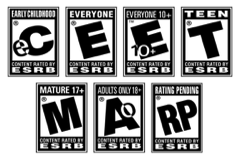Buying a Video Game for Your Child
4 Things to Keep in Mind When Buying a Video Game
Video games are among the most popular toys and there sure is a lot to choose from. Recent surveys tell us that 97% of US teenagers play these games and more than half played a video game the day before you read this paragraph. As a result of this demand, the video game industry is growing exponentially. Almost every week a new game hits store shelves. At a time when average price for a new release is around $40-60 range, it leaves parents with a tough decision to make on what game to purchase for their kids.
So, how can you decide which game to buy for your child? First, find out about the video game you consider purchasing. Check the rating by Entertainment Software Rating Board (a.k.a., ESRB rating) listed on the cover. Keep in mind that the rating may not yield enough information on a game's content. It may be rated as appropriate, but you may still not feel comfortable with your child playing what is featured. To remedy this, check with some nonprofit websites offer valuable information on game content, reviews and videos of gameplay and synopsis (e.g., www.whattheyplay.com or www.commonsensemedia.org). After you narrow down the available options by pushing through this filter, you can further shorten the list by applying the following 4 criteria:
Does the game feature a multiplayer option? This will not only offer your child the opportunity to play with friends in real life, but also allow you to join your child in game play when you can. If you have concerns on whether you can play well enough and not bore your child, please read “Playing Video games with Your Child.”
Does the game offer a variety of play modes, so that you can play with or against others? Competitive mode means you play against another player and cooperative mode means you join with another player and take on the challenges the game
Does the game allow your child to create characters, places and then immerse them into the game? More games now allow the player to create an image they like and put it into the game to substitute the hero or elements of game setting. This feature enables the child to personalize the game and share his creative skills with friends and, perhaps, you.
Finally, will the game support your child's interest? A kid with some interest in certain activities such as sports or hobbies, but lacking the self-confidence to get out there and play with peers could enjoy playing it on screen and slowly move towards a more courageous position. We know that kids who played realistic sports games such as basketball, football and skateboarding tend to spend more time on exercise than the kids who do not play those games. So, to boost a child's interest in certain activities or hobbies, one may consider conveniently plugging in a game with similar content.
In other words, purchase a game that you too will enjoy and feel comfortable playing with your child. After all, your time and your preparedness to play with your child is the best gift you can give.

